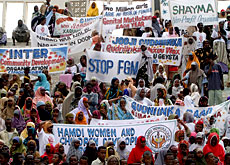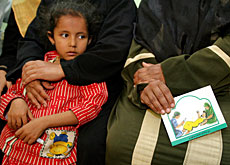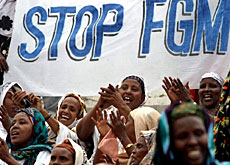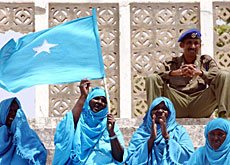First court case of genital mutilation

For the first time a case of female genital cutting that took place in Switzerland has been brought before a Swiss court.
The Zurich prosecutor’s office has launched criminal proceedings against two parents originally from Somalia who had their daughter genitally mutilated at their home in the Zurich Oberland when she was two.
“You have to give a signal that children growing up in Switzerland have to be protected from mutilation and you have to raise awareness,” Alexandra Rosetti from the Swiss section of the United Nations children’s organisation, Unicef, told swissinfo.
“This is one of the ways to show that this is not allowed and this is against children’s rights.”
The criminal proceedings were triggered in September when a doctor examined the now 13-year-old girl and noticed signs of genital mutilation. The doctor reported this to a court of guardianship, which filed a complaint.
On October 22 the girl’s parents – who admitted they had had their daughter circumcised – were arrested for being accomplices. They were released on Friday.
Michael Scherrer, the prosecutor dealing with the case, said on Friday he would bring a lawsuit for grievous bodily harm before Zurich cantonal court by the beginning of next year.
Grievous bodily harm can be punished by up to ten years in prison.
Scherrer assumes the circumcision was performed by someone from Somalia who had come into Switzerland specifically and then left, but he admits proving this is now almost impossible.
Proof
Rosetti confirmed it was the first time that such a process had been opened in Switzerland.
“This is the first time that we have proof,” she said, but added she was not surprised.
Female genital cutting is not limited to Africa, with doctors in Switzerland reporting an increasing number of mutilated girls and women as patients, as a result of migration.
“We’ve done two anonymous studies, in 2001 and 2004, in which we asked people involved in medical and social care whether they were confronted by female genital mutilation,” she said.
“In 2004 the number of people who said they were concerned with it had risen to 61 per cent. From that we estimated that around 7,000 girls or women in Switzerland have either been threatened by mutilation or already been mutilated.”
She added: “It is obvious looking at these answers that female genital mutilation is being performed in Switzerland.”
Law
The House of Representatives and the Senate have both approved a parliamentary initiative demanding a ban on female circumcision.
The initiative called for not only prosecution of those who carry out or support genital cutting in Switzerland, but also of those who support the practice abroad.
However, the initiative has yet to be made law.
“[Female genital mutilation] is not explicitly mentioned in Swiss law,” said Rosetti.
“If you look at the four different forms of mutilations, only the two strong forms [infibulation and excision] are considered grievous bodily harm. However, we say any form of mutilation has to be forbidden and has to be mentioned in the Swiss law.”
Traumatic results
Unicef Switzerland says the injuries from genital cutting – which are not carried out by doctors in Swiss hospitals but done in secrecy and in unhygienic conditions – often have traumatic results, including lifelong pain during intercourse and complications when giving birth.
Girls are either taken abroad or those who carry out the cutting travel to Switzerland and mutilate them before leaving the country.
Most of the mutilated girls in Switzerland come from Somalia, Ethiopia and Eritrea.
Nevertheless Rosetti believes progress is being made. “We’re definitely going in the right direction, but it can’t happen fast enough,” she said.
“We’ve been discussing this issue for years now and it has to be stopped as soon as possible.”
swissinfo, Thomas Stephens
Most frequent incidence of female genital mutilation (Unicef figures)
Guinea: 99% (legally banned since 2002)
Egypt: 97% (legally banned since 1996)
Mali: 92% (punishable as bodily harm)
Somalia: around 90%
Sudan 90%
Genital cutting is a cultural tradition in many African countries, with girls who have not been circumcised deemed unfit for marriage. Unicef Switzerland has supported successful educational campaigns in Burkina Faso, Somalia and Gambia.
The World Health Organization estimates 100-140 million girls and women have undergone female genital mutilation and Unicef claims that up to a further three million girls, mostly aged between four and 12, have their genitals cut every year.
As a result of immigration from Africa, genital cutting has also become an issue in Europe. It has been banned in Austria, Belgium, France, Denmark, Britain, Norway, Spain and Sweden.

In compliance with the JTI standards
More: SWI swissinfo.ch certified by the Journalism Trust Initiative




You can find an overview of ongoing debates with our journalists here. Please join us!
If you want to start a conversation about a topic raised in this article or want to report factual errors, email us at english@swissinfo.ch.